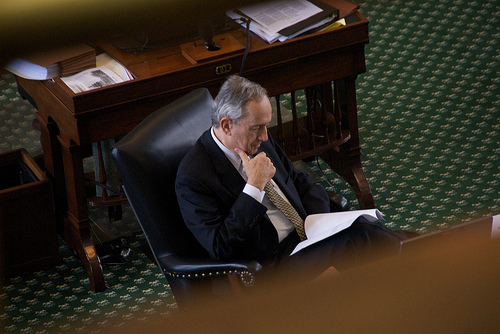AUSTIN, TEXAS—Taxpayer Savings Grants would save Texas taxpayers $2 billion in the program’s first two years and give families unprecedented school choice, Joe Bast, president of The Heartland Institute, testified Friday before the Texas Senate Committee on Education.
Bast was one of several experts testifying on school choice, including variations on vouchers, education tax credits, and lifting the state’s cap of 215 charter schools, as methods to improve education while preventing further budget deficits caused by education spending.
“Texas’s lieutenant governor says he really likes [taxpayer savings grants], and Gov. [Rick] Perry’s people say that he really likes it,” Bast said. “This would be the first non-means-tested, statewide, voucher-in-effect program.”
TSG is a Texas bill that would allow parents to transfer their child from a public school to a private school, using a grant to help pay tuition. The state would reimburse parents for the cost of tuition or 60 percent of the state average per-pupil expenditure—approximately $5,200, on average—whichever is less.
Texas taxpayers would save an average of $3,429 for each grant, leaving more money to spend on students who remain in government schools. Bast has calculated approximately 6.6 percent of public school students’ families would choose a TSG in its first year, or as many as 300,000 students.
In 2011, Texas legislators cut $4 billion from education to stem a massive deficit, and they expect another big deficit this year. Texas currently spends approximately $45 billion each year on K-12 education.
The Heartland Institute publishes School Reform News.
Empowering Parents, Students
Matthew Ladner told the committee school choice reverses the top-down approach of school administrators and government. Ladner is a senior policy and research advisor to the Foundation for Excellence in Education.
“We like to think of school choice as a bottom-up solution that empowers parents and students,” he said.
Ladner discussed the success of Florida’s McKay Scholarships for Students with Disabilities, which provided more than 24,000 special-needs students the opportunity to attend a participating private school during 2011-2012.
Although Texas has partially embraced charter schools, it has not advanced broader choice such as that offered in vouchers, noted Robert Enlow, president of the Friedman Foundation for Educational Choice.
He cited Indiana’s recent experience. The state has begun the second year of a statewide voucher program that grants vouchers worth up to approximately $5,000. Last year, just over 3,900 students signed up. This year, the state reports that number has more than doubled.
“We know from the first year that Indiana children are learning more and retaining more,” he told the committee.
When asked by state Sen. Wendy Davis (D-Fort Worth) what sort of accountability the program provided, Enlow responded private and charter schools are more accountable than public schools because they are accountable directly to parents and to state testing requirements.
Schools Likened to Factories
Texas schools currently treat students like products in a ball-bearing factory, where each unit must meet specifications and be identical, said Andrew Erben, president of the Texas Institute for Education Reform.
“We’re not addressing [students’] differences,” he said.
Erben suggested introducing more competition and eliminating wasteful spending.
“We should be letting the parents and students decide what’s best for them. The numbers show that we do not have enough options for them,” he told senators.
Many more parents want school choice than can access it in Texas, said Matthew Barnes, executive director of Families Empowered. He noted KIPP Charter Schools and Yes Prep Public Charter Schools in Houston had more students waitlisted than enrolled. Their waitlists top 12,000 students.
“There really is a demand for higher-standard schools,” he said.
Benefits to Teachers
Bast says teachers, who often fiercely oppose vouchers, should support TSG.
“Oftentimes teachers in rural areas are employed in a monopsony [many sellers, one buyer] market. But when competition is introduced for their skills, they are paid more, conditions improve, and more money flows into the classroom,” he said.
Wherever school competition exists, parents, students, and teachers are better matched, “so the TSG program will provide a win, win, win situation,” he said.
In the 2011 legislative session, TSGs were considered tax legislation rather than education legislation, Bast noted.
“There is a laundry list of ways you can design a voucher program, but ours is only two paragraphs long,” he said.
Image by Becky Lai.





